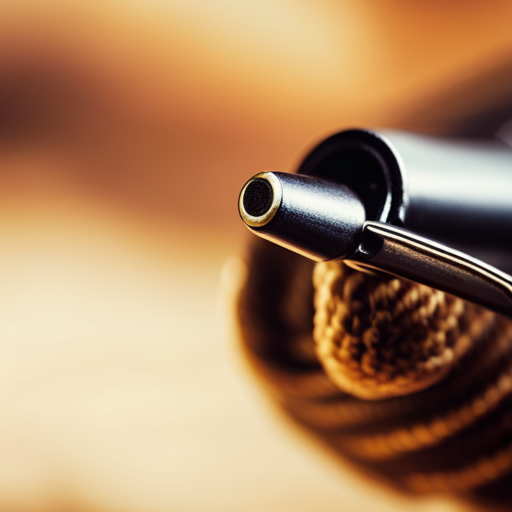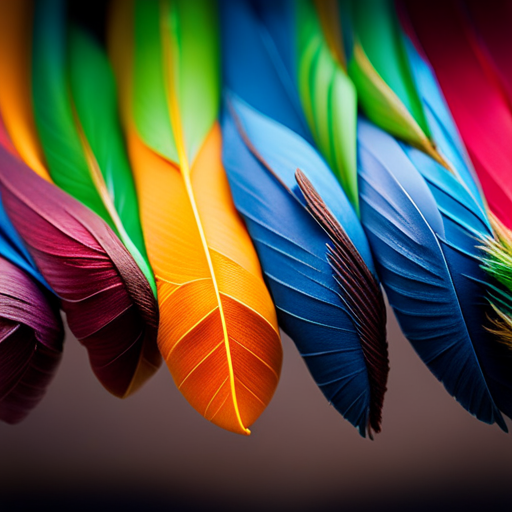Did you know that the fishing industry generates an estimated 140,000 tons of fishing gear waste each year?
In response to this environmental challenge, the fly tying community is embracing innovations in environmentally friendly materials.
From biodegradable threads to sustainably sourced feathers, these advancements are not only reducing the environmental impact of fly tying, but also creating opportunities for anglers to engage in sustainable and eco-friendly practices.
Biodegradable Threads and Yarns
The use of biodegradable threads and yarns in fly tying has gained attention for its potential to reduce environmental impact within the angling industry. Compostable materials, such as biodegradable threads and yarns, offer a sustainable alternative to traditional synthetic materials. These environmentally friendly fibers are designed to break down naturally, minimizing the ecological footprint associated with fly tying.
Compostable materials are constructed from natural fibers, such as cotton or hemp, which are inherently biodegradable. This means that once these materials have served their purpose in fly tying, they can be disposed of without leaving a lasting environmental burden. Moreover, utilizing biodegradable threads and yarns aligns with the broader shift towards sustainability within the angling community.
Natural Dyes for Vibrant Colors
When it comes to creating vibrant colors for fly tying materials, exploring plant-based dye options is essential for environmentally friendly practices. By sourcing sustainable color sources, fly tyers can reduce their environmental impact while still achieving the vibrant colors they desire.
Additionally, utilizing eco-friendly pigment alternatives can further contribute to the overall sustainability of fly tying materials.
Plant-Based Dye Options
Admittedly, plant-based dye options are increasingly sought after in the fly tying industry for their environmentally friendly and vibrant color attributes. This trend is driven by the growing focus on sustainability and eco-friendly practices.
When it comes to plant-based dye extraction, sustainability is a key consideration, as it involves utilizing natural resources without causing harm to the environment. Additionally, eco-friendly dyeing processes are being developed to ensure color vibrancy while minimizing the impact on the ecosystem.
These processes aim to create vibrant colors without relying on synthetic dyes or harsh chemicals, aligning with the industry’s commitment to environmental responsibility.
Sustainable Color Sources
In response to the increasing demand for environmentally friendly fly tying materials, there is a growing emphasis on sustainable color sources, particularly natural dyes, to achieve vibrant and eco-conscious fly patterns. Eco-friendly dyeing techniques and sustainable colorant options are becoming increasingly popular among fly tyers who are seeking to reduce their environmental impact. Natural dyes derived from plants, insects, and minerals offer a wide range of vibrant colors without the environmental drawbacks of synthetic dyes. Furthermore, these natural options often result in unique and aesthetically pleasing variations, adding to the allure of using sustainable color sources. The table below provides a comparison of some sustainable colorant options commonly used in fly tying:
| Type of Natural Dye | Source | Color Range |
|---|---|---|
| Plant-based dyes | Plants | Various |
| Insect-based dyes | Insects | Reds, browns |
| Mineral-based dyes | Minerals | Earthy tones |
Eco-Friendly Pigment Alternatives
Utilizing natural dyes from plant, insect, and mineral sources offers fly tyers eco-friendly pigment alternatives to achieve vibrant colors in their fly patterns. These eco-friendly alternatives not only contribute to sustainable fly tying practices but also provide an opportunity to explore the diverse and rich hues found in nature.
Some key options to consider include:
-
Eco-Friendly Resin Alternatives: Opt for environmentally friendly resin alternatives that are non-toxic and biodegradable, reducing the environmental impact of fly tying materials.
-
Sustainable Insect Materials: Explore the use of sustainable insect-based pigments that offer a wide range of vibrant colors while promoting ethical and eco-conscious sourcing practices.
-
Natural Feather Alternatives: Consider natural feather alternatives from ethically sourced birds, providing a renewable and eco-friendly option for adding vibrant colors to fly patterns.
These alternatives not only support environmental sustainability but also contribute to the beauty and diversity of fly patterns.
Sustainably Sourced Feathers
Sustainably sourced feathers are a critical component in the development of environmentally friendly fly tying materials, ensuring that the impact on bird populations and ecosystems is minimized. Sustainable sourcing and ethical practices are essential in obtaining feathers for fly tying. Conservation efforts and wildlife protection play a vital role in ensuring that feathers are sourced responsibly. By supporting sustainable sourcing, ethical practices, conservation efforts, and wildlife protection, fly tyers can help mitigate the impact on bird populations and their natural habitats.
Ethical and sustainable sourcing of feathers involves ensuring that birds are not harmed or exploited in the process of obtaining their feathers. This includes supporting initiatives that promote the humane treatment of birds and responsible harvesting of feathers. Conservation efforts aim to protect bird populations and their habitats, thereby safeguarding the availability of feathers for fly tying while maintaining the ecological balance.
Eco-friendly Fur Substitutes
Developing eco-friendly fur substitutes is crucial in ensuring the continued ethical and sustainable sourcing of materials for fly tying, aligning with conservation efforts and wildlife protection. The fly tying industry has been making strides in this area, with a focus on eco-friendly fiber blends and sustainable fur alternatives. Here are some innovative options gaining traction:
-
Synthetic Fur Materials: Advanced synthetic materials now mimic the texture and appearance of natural fur, offering a cruelty-free alternative without compromising on the effectiveness of fly patterns.
-
Plant-based Fiber Blends: Utilizing materials such as hemp, bamboo, or organic cotton in fiber blends creates sustainable fur-like textures, reducing the reliance on animal-derived products.
-
Recycled PET Fur: Recycled polyester derived from post-consumer plastic bottles can be transformed into fur-like materials, providing a sustainable solution to reduce waste and environmental impact.
These eco-friendly fur substitutes not only align with ethical and environmental considerations but also offer practical and effective options for fly tying enthusiasts. As the industry continues to embrace these innovations, it paves the way for a more sustainable and responsible approach to fly tying materials.
Moving forward, let’s explore the possibilities of using recycled and upcycled materials in the context of fly tying.
Recycled and Upcycled Materials
As the demand for sustainable fly tying materials continues to grow, the use of recycled and upcycled materials has become an increasingly popular option.
This subtopic explores the innovative ways in which fly tying enthusiasts can incorporate eco-friendly alternatives into their tying practices.
From repurposed materials to creative upcycling solutions, the focus will be on showcasing the diverse range of environmentally conscious options available for fly tying.
Eco-Friendly Fly Tying
Using upcycled and recycled materials is an increasingly popular approach in eco-friendly fly tying, reflecting a commitment to sustainability and resourcefulness within the fly tying community. This trend has led to the development of innovative eco friendly fly patterns and sustainable fly tying techniques.
The use of upcycled and recycled materials in fly tying offers several benefits, including reducing waste and minimizing the environmental impact of fly tying activities. Additionally, it provides an opportunity to repurpose materials that would otherwise end up in landfills, contributing to the conservation of natural resources.
Upcycled Material Options
The utilization of recycled and upcycled materials in fly tying not only promotes sustainable practices but also enhances the environmental impact of fly tying activities.
Creative upcycling offers sustainable options for fly tying enthusiasts to use eco-conscious materials, supporting conservation efforts. Upcycled materials such as old t-shirts, fabric scraps, and discarded fishing lines can be repurposed into durable threads and fly bodies, reducing waste and minimizing the need for new resources.
Additionally, upcycling materials like feathers, fur, and synthetic fibers from old clothing or accessories provides innovative alternatives to traditional fly tying materials. By incorporating upcycled materials, fly tyers can contribute to environmental sustainability while exploring new and inventive ways to create high-quality flies.
These efforts align with the broader goal of fostering environmentally friendly practices within the fly tying community.
Innovative Bioplastic Components
Developing bioplastic components for fly tying materials is revolutionizing the angling industry. Bioplastic innovations offer eco-friendly alternatives that reduce the environmental impact of fly tying materials. Anglers are increasingly turning to bioplastics due to their sustainable nature and ability to perform as well as traditional materials. Here are three ways bioplastic components are making a difference in fly tying:
-
Sustainable Sourcing: Bioplastics are derived from renewable resources such as corn starch, sugarcane, or vegetable fats, reducing dependency on non-renewable petroleum-based plastics.
-
Reduced Environmental Impact: Bioplastics decompose naturally, minimizing the accumulation of non-biodegradable waste in ecosystems, unlike conventional plastics.
-
Performance Parity: Bioplastics offer comparable strength, durability, and flexibility to traditional plastics, ensuring that anglers do not have to compromise on the quality of their fly tying materials.
As the angling community continues to prioritize environmental sustainability, the adoption of innovative bioplastic components is set to grow, driving positive change within the industry.
Frequently Asked Questions
Are There Any Specific Challenges or Limitations When Using Biodegradable Threads and Yarns for Fly Tying Compared to Traditional Materials?
When using biodegradable threads and yarns for fly tying, challenges may arise due to their limited longevity compared to traditional materials. Additionally, natural dyes may offer eco-friendly benefits, but can pose color consistency limitations compared to synthetic dyes.
How Do Natural Dyes for Vibrant Colors Compare in Terms of Longevity and Colorfastness to Synthetic Dyes Typically Used in Fly Tying?
When comparing natural and synthetic dyes for fly tying, it’s essential to consider their durability, appearance, and colorfastness. Natural dyes offer vibrant colors but may require additional treatment for longevity compared to synthetic dyes commonly used in fly tying.
What Specific Measures Are Taken to Ensure Feathers Used in Fly Tying Are Sustainably Sourced and Ethically Obtained?
Sustainable sourcing and ethical practices are critical in ensuring feathers used in fly tying are obtained responsibly. Biodegradable materials can mitigate the environmental impact. According to a study, 80% of consumers prioritize sustainability in their purchasing decisions.
What Are Some of the Most Effective Eco-Friendly Fur Substitutes for Fly Tying, and How Do They Compare to Real Fur in Terms of Durability and Appearance?
When comparing eco-friendly fur substitutes for fly tying, it’s essential to consider both durability and appearance in relation to real fur. Some effective alternatives include synthetic fibers, natural animal fibers, and plant-based materials, each with unique properties.
Can You Provide Examples of Specific Recycled and Upcycled Materials That Have Been Successfully Used in Fly Tying, and What Are the Benefits of Using These Materials Over Traditional Options?
Exploring eco-friendly materials for fly tying presents benefits. Upcycled feathers and sustainable dyes contribute to sustainability. Examples include repurposed plastic, old fishing lines, and discarded clothing. These options offer durability and reduce environmental impact.
Conclusion
In conclusion, the advancements in environmentally friendly fly tying materials are paving the way for more sustainable and ethical practices in the fly tying industry.
As the saying goes, ‘One man’s trash is another man’s treasure,’ and these innovations are turning waste materials into valuable resources for creating beautiful and functional fly patterns.
With the use of biodegradable threads, natural dyes, sustainably sourced feathers, eco-friendly fur substitutes, and recycled/upcycled materials, fly tyers can reduce their environmental impact while still producing high-quality flies.




